Today we will introduce the diesel and electric locomotive fleet of Pakistan to our readership. We will start our introduction with the most powerful locomotives of Pakistan Railways. These are the 3000 horse power units. We will cover lesser horse power and steam engines in later posts
(1) HGMU30
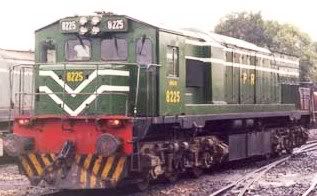 The abbreviation HGMU30 stands for ‘Henschel General Motors Universal, 3000hp’. They are called Universal units because they can be used both on freight and passenger trains. These locomotives were built in 1985 at Henschel factory and Pakistan Railways owned 30 of these units from serial number 8201 to 8230. These units are also called EMDs as they were built by the Electro-motive division of General Motors.
The abbreviation HGMU30 stands for ‘Henschel General Motors Universal, 3000hp’. They are called Universal units because they can be used both on freight and passenger trains. These locomotives were built in 1985 at Henschel factory and Pakistan Railways owned 30 of these units from serial number 8201 to 8230. These units are also called EMDs as they were built by the Electro-motive division of General Motors.
(2) DPU30
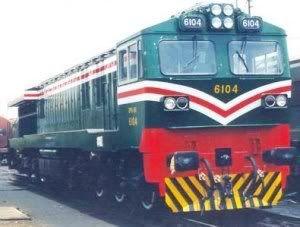 The abbreviation DPU30 stands for Dahlian Pakistan Universal, 3000hp. These locomotives were manufactured in 2004 in the Chinese city of Dahlian, hence the designation DPU30. Pakistan bought 9 such units (Serial Number 6101-6109) from China whereas 35 more units were to be assembled in Pakistan (Serial Number 6110-6144), hence the designation DPU30. The alphabet U in DPU stands for Universal load which means passenger and freight both.
The abbreviation DPU30 stands for Dahlian Pakistan Universal, 3000hp. These locomotives were manufactured in 2004 in the Chinese city of Dahlian, hence the designation DPU30. Pakistan bought 9 such units (Serial Number 6101-6109) from China whereas 35 more units were to be assembled in Pakistan (Serial Number 6110-6144), hence the designation DPU30. The alphabet U in DPU stands for Universal load which means passenger and freight both.
In early 2005, Eight DPU30s’ from serial number 6101 to 6108 developed cracks in their frames. 6104 (photographed above) was the most affected. These locos were then withdrawn from passengers services and after crack welding was done they were relegated to hauling freight loads. Later Chinese engineers came to Pakistan and did the necessary repair work under warranty and all DPUs are now back in service and being fully utilized.
(3) AGE30
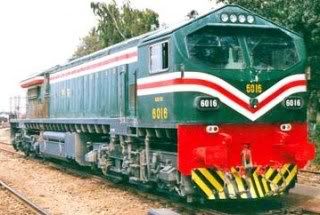 The abbreviation AGE30 stands for AdTranz General Electric, 3000hp. These locomotives have serial numbers of 60xx series.
The abbreviation AGE30 stands for AdTranz General Electric, 3000hp. These locomotives have serial numbers of 60xx series.
In rest of the world these locomotives are used with a driver cab on both ends but for Pakistan these were built with cab on one side only. These locomotives were so long that in the begining there were no turn tables long enough to rotate these locos in some cities. Therefore on one side of the journey the driver cab was at the back of the engine andto to gave a very bad view to drivers. It is said that some drivers refused to run these locos in such configuration.
(4) GMU30
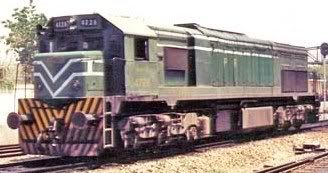 The abbreviation GMU30 stands for General Motors Universal, 3000hp.
The abbreviation GMU30 stands for General Motors Universal, 3000hp.
These units are similar to HGMU30s described in (1) above except they are older and were not manufactured at Henschel factory therefore the alphabet H is missing from their designation. These locomotives were built in 1975 and Pakistan owned 36 such units. Their serial numbers ranged from 4701 to 4736.
(5) BCU30
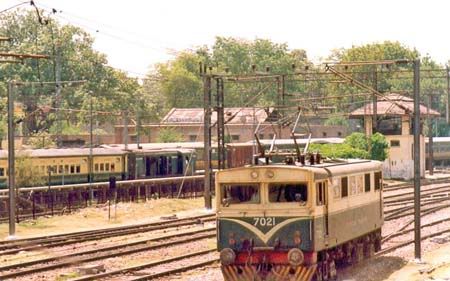 The abbreviation BCU30 stands for British Consortium Universal, 3000 horse power. Pakistan got 29 of these units starting in 1964. Their serial numbers were 7001 to 7029. These units could only be used on the 276 km route between Lahore and Khanewal as only this length of Pakistan’s Rail network is electrified.
The abbreviation BCU30 stands for British Consortium Universal, 3000 horse power. Pakistan got 29 of these units starting in 1964. Their serial numbers were 7001 to 7029. These units could only be used on the 276 km route between Lahore and Khanewal as only this length of Pakistan’s Rail network is electrified.
These locomotives work on AC (alternating current) traction of 25000 Volts.
BCU30s have now outlived their operational life and most of them are now relegated to freight hauling only. In 2007 one such BCU30 unit with serial number 7027 has actually been placed in Railway Heritage Museum at Golra
ACKNOWLEDGEMENTS:
All photos of this post come from Mr. Rana Rashid and Mr. Zakir Khan’s website called Pakistanrail.com
ATP’s Posts on Pakistan Railway:
1. Khyber Pass Railway
2. Bolan Pass Railway
3. The Trans-Balochistan Railway
4. Changa Manga Forest Railway
5. Lansdowne Bridge, Sukkur
6. Railway Bridge on Indus at Attock
7. Khojak Tunnel
8. Chappar Rift
9. Karachi Circular Railway – Revival gets 1 step closer
10. Zhob Valley Railway (ZVR)
11. How the First Locomotive Reached Lahore
12. 3000hp Iron Horses of Pakistan
13. Karachi Tramway of Yesteryears
14. Lahore Rapid Mass Transit Rail Project
15. A Phoenix Rises From the Ashes of Bakhshapur
16. ek masla hai… A Railway Runs Through It
17. Ava Gardner in Lahore for Bhowani Junction
18. The Meter-Gauge of Sindh
19. Indus Flotilla Company
20. Karachi to Kotri: First Railways in Pakistan
21. Pakistan Railway on the West Bank of Indus
Pakistan Railway Discussion Group:
If you want to learn more about Pakistan Railways, then feel free to join the ‘Pakistan Railway (PR)’ discussion group. Everything and anything related to PR is discussed here e.g. preserving of Pakistan’s rail heritage, steam locomotives, sharing of photos and news, time tables etc. You can join the discussion group here.



















































The HGMU 30 series loco is a real master. I have always been facinated by it. Although I now live in Rawalpindi and get bored looking at the Hitachi 2000hp, I really do not waste anytime while in Karachi or Lahore to peek a boo on the HGMU 30. I also have the rare honour of sitting in the cabin twice on the Lahore Khanewal section. The PR has blocked the throttle power of these beasts at 7, whereas they have throttle at 10. These locos are capable of pulling 2500tons and were better than the chinese ones that we have now. The PR, obviously, under the able guidance of the then Minister, a retired General Jawed Ashraf, and under the very able (mis)guidance of the now minister Sheikh Rashid, is headed nowhere fast and I hope it doesnt exceed the 95kms on this route.
By the way, has anyone seen the programme on NatGeo on the Indian Railways?
Owais, thank you for your clarification.
Babbii, you are right. The rated speed at most sections is 95kmph. The ‘Clear’ sign means speed restrictions are over and speed can be increased to rated speed. For Pakistani built coaches (green and yellow livery), rated speed is 95-105 kmph. The Chinese coaches with blue/white livery speed limit is 140 kmph. These coaches are now being assembled in Pakistan. If you look at these coaches then on the side it is even printed in bold letters: Speed 140kmph. But as I said earlier 140kmph is only allowed in certain sections.
You are right that diesel engines are actually diesel-electric hybrids.
You are also right on 7000 electric series now being relegated to freight or slow passenger service only. These engines are more than 40 years old now.
I wonder if all engine variants can run on 140kph.!! I have travelled a lot by trains in my childhood/teenage and out of curiosity have minutely observed all the railways’ signs etc. The max speed sign which I have seen is “95kmph” alongwith the “CLEAR” sign and while interviewing one of the drivers he said the max is 120kph. I think the sections they run on 140kph is kind of an unofficial permission to cover the delays.
The 7000series Electric locos are not in a good shape apparently and I have noticed while travelling that the electric locos are not used for express trains. Are they slow?.
Owais one thing I think you forgot to mention that these are diesel-electric hybrid locos. The diesel engine is used to make electricity which is then used to run traction motors in the wheels.
If that doesn’t make sense – notice the mismatched units (hp cc)…